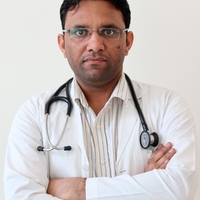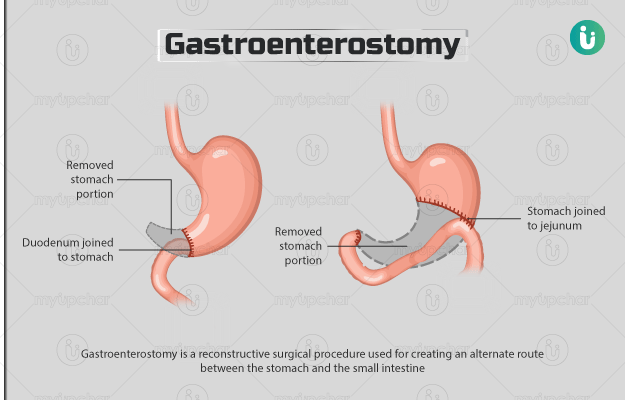Summary
Gastroenterostomy is a surgical procedure that is done to create an alternate route (a bypass) between the stomach and small intestine. The surgery is generally recommended in case of a gastric obstruction or after removal of a portion of the stomach (say for removal of a tumour). When a new passage is created between the stomach and the duodenum (the first part of the small intestine), the surgery is called gastroduodenostomy. On the other hand, if a new connection is made between the stomach and jejunum (the second part of the small intestine), the surgery is called gastrojejunostomy.
You will be admitted to the hospital a day before the surgery and will be given an enema to empty your stomach contents. The procedure will be performed under general anaesthesia, a medicine to make you fall asleep. Gastroenterostomy can be carried out by a conventional method (requires a large cut on the abdomen) or laparoscopic method (requires small cuts on the abdomen). You will need to revisit the hospital one to two weeks after surgery for postoperative evaluation.
- What is gastroenterostomy?
- Why is gastroenterostomy recommended?
- Who can and cannot get gastroenterostomy?
- What preparations are needed before gastroenterostomy?
- How is gastroenterostomy done?
- How to care for yourself after gastroenterostomy?
- What are the possible complications/risks of gastroenterostomy?
- When to follow up with your doctor after a gastroenterostomy?
What is gastroenterostomy?
Gastroenterostomy is a reconstructive surgical procedure used for creating an alternate route between the stomach and the small intestine.
Small intestine is a long narrow tube that connects your stomach and large intestine. Small intestine consists of three parts, namely duodenum (the first part that starts from the end of the stomach), jejunum (the second part), and ileum (the third part).
During gastroenterostomy a bypass is either created between the stomach and duodenum - gastroduodenostomy or jejunum - gastrojejunostomy.
This surgery is usually performed after a portion of the stomach is removed or in the presence of tumours that obstruct the digestive tract. The alternate route helps to restore gastrointestinal continuity.
Why is gastroenterostomy recommended?
Gastroenterostomy is recommended in individuals with the following conditions:
- Tumour in the stomach. Symptoms of the condition include:
- Heartburn
- Blood in the stool
- Swelling in the abdomen
- Poor appetite
- Periampullary tumour or tumour in the duodenum. These tumours may result in symptoms such as:
- Abdominal pain
- Yellowing of the eyes and skin
- Weight loss
- Vomiting
- To drain stomach contents in peptic ulcer surgeries such as vagotomy (reduces acid secretions in the stomach)
- To restore continuity of the digestive tract after removal of a part of the stomach by surgery
- For the treatment of morbid obesity (obesity that affects basic functions such as walking and breathing)
Who can and cannot get gastroenterostomy?
The relative contraindications (surgery can be performed but with caution) of gastroenterostomy include:
- Severe hypoalbuminaemia (low albumin levels in blood)
- Presence of a coexisting condition that does not allow for this surgery
- Extremely short life expectancy due to the spread of cancerous cells to other organs of the body
What preparations are needed before gastroenterostomy?
You will need to visit the hospital a few days before the surgery for a preoperative evaluation wherein the surgeon will conduct several medical or imaging tests. These include:
- Blood tests
- Pregnancy test
- Upper gastrointestinal contrast study (a special type of X-ray used to look for obstructions in the stomach)
- Endoscopy (a procedure to investigate the internal organs using a long, flexible tube with a camera and light source fitted at one end)
- Computed tomography (an imaging test that creates detailed pictures of organs inside the body)
You will be given certain instructions to prepare for the surgery. The surgeon will ask you to:
- Share with them a list of all the medicines that you take, including herbs and over-the-counter medications.
- Stop taking any blood thinners (aspirin, warfarin, ibuprofen, etc.) about a week before the surgery.
- Stop smoking.
- Fast after midnight of the night preceding surgery. Fasting is recommended to prevent vomiting (risk of anaesthesia) during the operation.
- Arrange for a friend or family member to drive you home after the surgery.
- Take a shower and remove nail polish, make-up, and body piercings before arriving at the hospital for the surgery.
- Sign a consent form to grant your permission for the procedure.
How is gastroenterostomy done?
You will need to be admitted in the hospital a day before the surgery. After admission, the hospital staff will provide you with a hospital gown. Subsequently, a special tube will be inserted into your stomach through your nose to empty the contents of your stomach. Essential fluids and electrolytes will be supplied to you to correct any imbalance if present. When the time arrives for the surgery, the medical staff will take you to the operating room. The procedure for gastroduodenostomy involves the following:
- You will lie on your back with arms spread out.
- A doctor will clean the skin over your abdomen with an antiseptic solution.
- An anesthesiologist will administer general anaesthesia to put you into a deep sleep.
- A tube will be inserted into your bladder to drain urine during the surgery.
- You will be given antibiotics to prevent infection.
- Your surgeon will make a cut (incision) in the midline on your abdomen, extending from your ribcage to your lower abdomen.
- He/she will cut and remove the affected portion of your stomach, taking care not to disturb any surrounding blood vessels.
- Thereafter, the surgeon will stitch your duodenum to the remnant of your stomach and close the original opening of your stomach into your duodenum.
- Finally, he/she will close the incision on your skin.
In gastrojejunostomy, the surgeon cuts and removes the affected lower part of the stomach. The upper portion of the stomach is then joined to the jejunum of the small intestine.
These surgeries may be performed by the laparoscopic method as well. In laparoscopic surgery, the surgeon makes tiny incisions on the abdomen for insertion of the laparoscope (a small tube containing a camera and light source at one end) and other instruments for surgery. Compared to conventional methods, laparoscopic approach is associated with a shorter hospital stay, lesser pain and scarring, and faster recovery.
When you wake up after the surgery, you may feel tired and groggy and experience sore throat, dry mouth, restlessness, etc. These side effects of general anaesthesia usually fade within a few hours. You may need medications to relieve pain during your hospital stay. The hospital staff will make you wear special support stockings to prevent the formation of blood clots in your legs.
How to care for yourself after gastroenterostomy?
Once you reach home, you will need to take care of yourself in the following manner:
- Keep the wound dry and clean. You may have a dressing over the incisions. The surgeon may allow you to remove the dressing after 48 hours. However, make sure to remove it if it gets dirty or wet before 48 hours. Clean the skin near the incision with mild soap and water.
- You may be allowed to shower 2 days after the surgery. However, avoid swimming or bathing in tubs unless allowed by the surgeon. Avoid rubbing on the incisions with a towel, gently pat it dry instead.
- Hold a pillow against your incisions while coughing or sneezing. It will help to reduce abdominal discomfort and protect your wound.
- The surgeon may prescribe painkillers, antibiotics, and laxatives (stool softeners). Take them as directed.
- You should strictly follow the diet restrictions given by the surgeon. He/she may suggest you to start with a liquid diet for the initial few days and later move on to your regular diet. Make sure to drink a lot of liquids. In case of constipation, eat fibre-rich foods.
- Avoid lifting heavy objects for six weeks. You should start walking gradually as suggested by the doctor.
- The surgeon may allow you to drive after one to two weeks if you do not feel any pain.
When to see the doctor?
Contact the surgeon if you experience any of the following after the surgery:
- Fever with body temperature over 100.4°F (38°C)
- Profuse sweating
- Chills
- Difficulty breathing
- Incisions break apart
- Bleeding or foul-smelling discharge from the incisions
- Increased pain, swelling, or redness around the wound
- Pain or hardness in the abdomen that persists even after taking medications
- Constipation, diarrhoea, or the inability to pass gas for over three days
- Inability to empty the bladder
- Blood in urine or blood in stool
- Skin rash
What are the possible complications/risks of gastroenterostomy?
The potential risks and complications associated with the surgery are:
- Peritonitis (inflammation of the tissue lining your abdomen)
- Skin infection
- Risks of anaesthesia such as confusion, heart attack, and stroke
When to follow up with your doctor after a gastroenterostomy?
You will need to revisit the hospital after one to two weeks for postoperative evaluation.
Disclaimer: The above information is provided purely from an educational point of view and is in no way a substitute for medical advice by a qualified doctor.
Find Gastroenterologist in cities
- Gastroenterologist in Gurgaon
- Gastroenterologist in Bangalore
- Gastroenterologist in Chennai
- Gastroenterologist in Jaipur
- Gastroenterologist in Ahmedabad
- Gastroenterologist in Noida
- Gastroenterologist in Mysore
- Gastroenterologist in Visakhapatnam
- Gastroenterologist in Hyderabad
- Gastroenterologist in Pune
Surgery Cost In Your City
Doctors for Gastroenterostomy

Dr. Rishabh Gupta
Gastroenterology
6 Years of Experience

Dr. Paramjeet Singh.
Gastroenterology
10 Years of Experience

Dr. Nikhil Bhangale
Gastroenterology
10 Years of Experience

Dr Jagdish Singh
Gastroenterology
12 Years of Experience
References
- Seattle Children's [Internet]. Seattle Children's Hospital. Washington DC. US; How the Small Intestine Works
- Clavien P-A, Sarr MG, Fong Y, Miyazaki M. Atlas of upper gastrointestinal and hepato-pancreato-biliary surgery. 2nd ed. Berlin: Springer; 2016. Chapter 28, laparoscopic and conventional gastroenterostomy; p. 247–254.
- American Cancer Society [Internet]. Georgia. US; Signs and Symptoms of Stomach Cancer
- Johns Hopkins Medicine [Internet]. The Johns Hopkins University, The Johns Hopkins Hospital, and Johns Hopkins Health System; Ampullary Cancer
- Rabben H-L, Zhao C-M, Hayakawa Y, Wang TC, Chen D. Vagotomy and gastric tumorigenesis. Curr Neuropharmacol. 2016 Nov;14(8):967–972. PMID: 26791481.
- University of Rochester Medical Center [Internet]. University of Rochester. New York. US; What is Morbid Obesity?
- National Health Service [Internet]. UK; Having an operation (surgery)
- Great Ormond Street Hospital for Children [Internet]. NHS Foundation Trust. National Health Service. UK; [link[
- Radiological Society of North America (RSNA) [internet]. Oak Brook. Illinois. USA; Computed Tomography
- Hernandez A, Sherwood ER. Anesthesiology principles, pain management, and conscious sedation. In: Townsend CM Jr, Beauchamp RD, Evers BM, Mattox KL, eds. Sabiston Textbook of Surgery. 20th ed. Philadelphia, PA: Elsevier; 2017:chap 14
- Cohen NH. Perioperative management. In: Miller RD, ed. Miller’s Anesthesia. 8th ed. Philadelphia, PA: Elsevier Saunders; 2015:chap 3
- Michigan Medicine [internet]. University of Michigan. US; Instructions following abdominal surgery
- Cardiovascular and Interventional Radiological Society of Europe [Internet]. Vienna. Austria; Gastrojejunostomy















